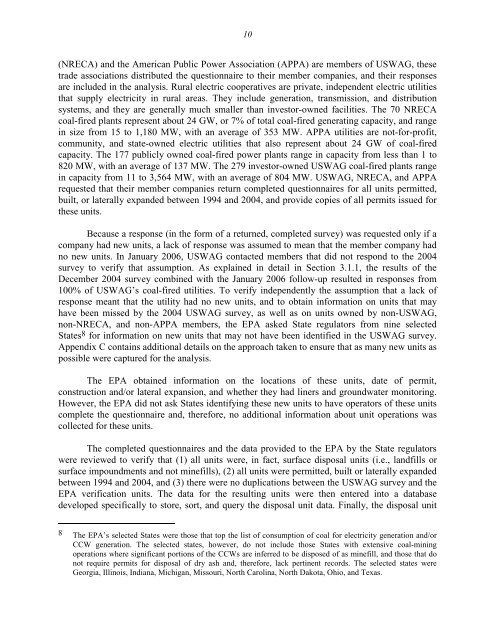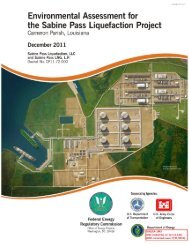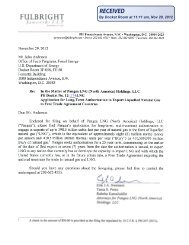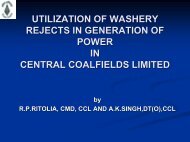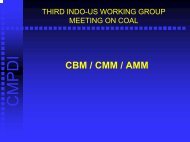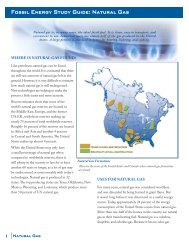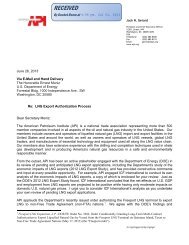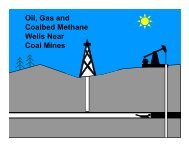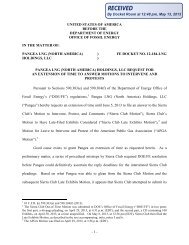Coal Combustion Waste Management at - DOE - Fossil Energy ...
Coal Combustion Waste Management at - DOE - Fossil Energy ...
Coal Combustion Waste Management at - DOE - Fossil Energy ...
Create successful ePaper yourself
Turn your PDF publications into a flip-book with our unique Google optimized e-Paper software.
10<br />
(NRECA) and the American Public Power Associ<strong>at</strong>ion (APPA) are members of USWAG, these<br />
trade associ<strong>at</strong>ions distributed the questionnaire to their member companies, and their responses<br />
are included in the analysis. Rural electric cooper<strong>at</strong>ives are priv<strong>at</strong>e, independent electric utilities<br />
th<strong>at</strong> supply electricity in rural areas. They include gener<strong>at</strong>ion, transmission, and distribution<br />
systems, and they are generally much smaller than investor-owned facilities. The 70 NRECA<br />
coal-fired plants represent about 24 GW, or 7% of total coal-fired gener<strong>at</strong>ing capacity, and range<br />
in size from 15 to 1,180 MW, with an average of 353 MW. APPA utilities are not-for-profit,<br />
community, and st<strong>at</strong>e-owned electric utilities th<strong>at</strong> also represent about 24 GW of coal-fired<br />
capacity. The 177 publicly owned coal-fired power plants range in capacity from less than 1 to<br />
820 MW, with an average of 137 MW. The 279 investor-owned USWAG coal-fired plants range<br />
in capacity from 11 to 3,564 MW, with an average of 804 MW. USWAG, NRECA, and APPA<br />
requested th<strong>at</strong> their member companies return completed questionnaires for all units permitted,<br />
built, or l<strong>at</strong>erally expanded between 1994 and 2004, and provide copies of all permits issued for<br />
these units.<br />
Because a response (in the form of a returned, completed survey) was requested only if a<br />
company had new units, a lack of response was assumed to mean th<strong>at</strong> the member company had<br />
no new units. In January 2006, USWAG contacted members th<strong>at</strong> did not respond to the 2004<br />
survey to verify th<strong>at</strong> assumption. As explained in detail in Section 3.1.1, the results of the<br />
December 2004 survey combined with the January 2006 follow-up resulted in responses from<br />
100% of USWAG’s coal-fired utilities. To verify independently the assumption th<strong>at</strong> a lack of<br />
response meant th<strong>at</strong> the utility had no new units, and to obtain inform<strong>at</strong>ion on units th<strong>at</strong> may<br />
have been missed by the 2004 USWAG survey, as well as on units owned by non-USWAG,<br />
non-NRECA, and non-APPA members, the EPA asked St<strong>at</strong>e regul<strong>at</strong>ors from nine selected<br />
St<strong>at</strong>es 8 for inform<strong>at</strong>ion on new units th<strong>at</strong> may not have been identified in the USWAG survey.<br />
Appendix C contains additional details on the approach taken to ensure th<strong>at</strong> as many new units as<br />
possible were captured for the analysis.<br />
The EPA obtained inform<strong>at</strong>ion on the loc<strong>at</strong>ions of these units, d<strong>at</strong>e of permit,<br />
construction and/or l<strong>at</strong>eral expansion, and whether they had liners and groundw<strong>at</strong>er monitoring.<br />
However, the EPA did not ask St<strong>at</strong>es identifying these new units to have oper<strong>at</strong>ors of these units<br />
complete the questionnaire and, therefore, no additional inform<strong>at</strong>ion about unit oper<strong>at</strong>ions was<br />
collected for these units.<br />
The completed questionnaires and the d<strong>at</strong>a provided to the EPA by the St<strong>at</strong>e regul<strong>at</strong>ors<br />
were reviewed to verify th<strong>at</strong> (1) all units were, in fact, surface disposal units (i.e., landfills or<br />
surface impoundments and not minefills), (2) all units were permitted, built or l<strong>at</strong>erally expanded<br />
between 1994 and 2004, and (3) there were no duplic<strong>at</strong>ions between the USWAG survey and the<br />
EPA verific<strong>at</strong>ion units. The d<strong>at</strong>a for the resulting units were then entered into a d<strong>at</strong>abase<br />
developed specifically to store, sort, and query the disposal unit d<strong>at</strong>a. Finally, the disposal unit<br />
8 The EPA’s selected St<strong>at</strong>es were those th<strong>at</strong> top the list of consumption of coal for electricity gener<strong>at</strong>ion and/or<br />
CCW gener<strong>at</strong>ion. The selected st<strong>at</strong>es, however, do not include those St<strong>at</strong>es with extensive coal-mining<br />
oper<strong>at</strong>ions where significant portions of the CCWs are inferred to be disposed of as minefill, and those th<strong>at</strong> do<br />
not require permits for disposal of dry ash and, therefore, lack pertinent records. The selected st<strong>at</strong>es were<br />
Georgia, Illinois, Indiana, Michigan, Missouri, North Carolina, North Dakota, Ohio, and Texas.


